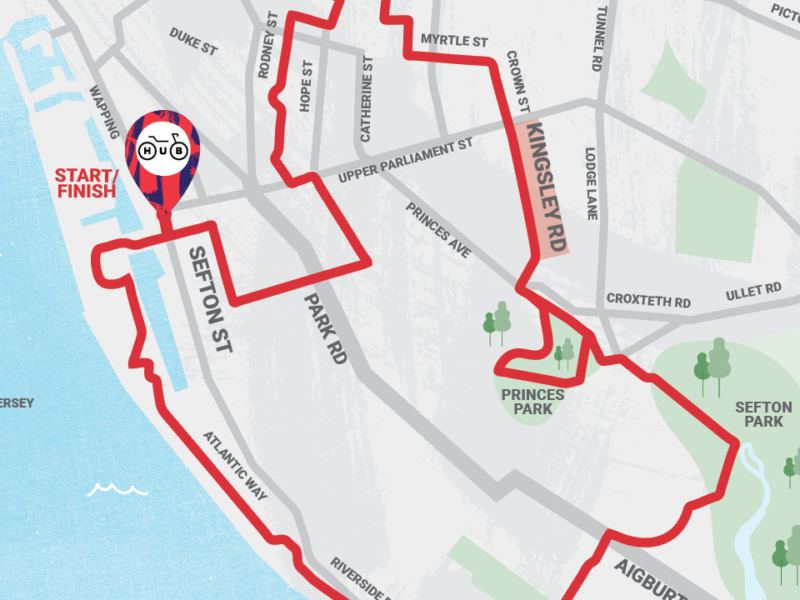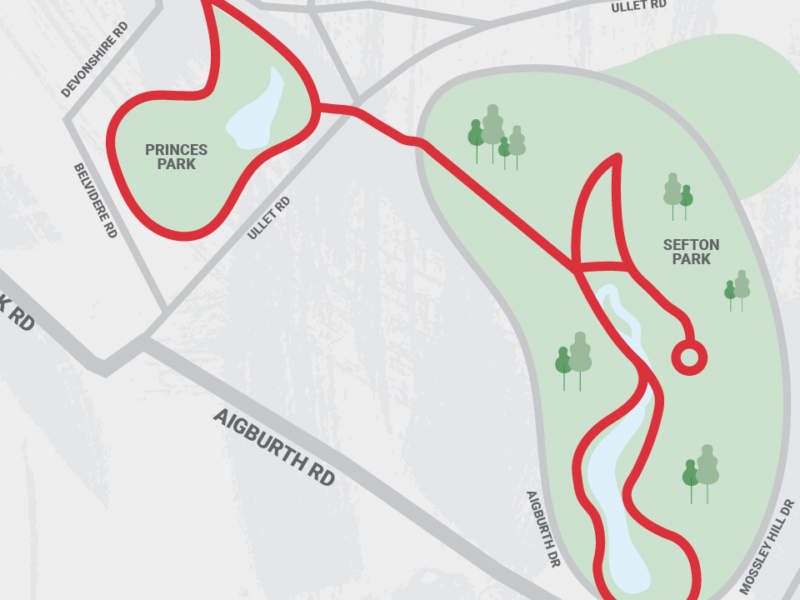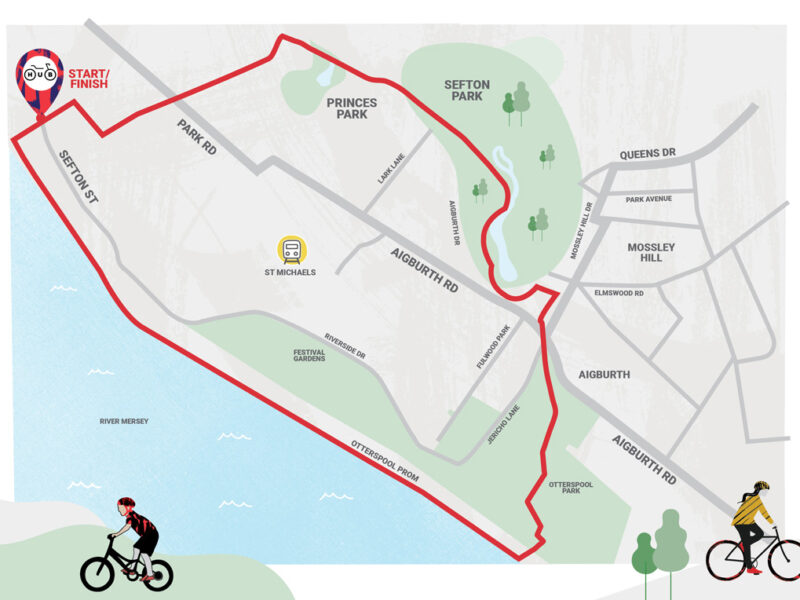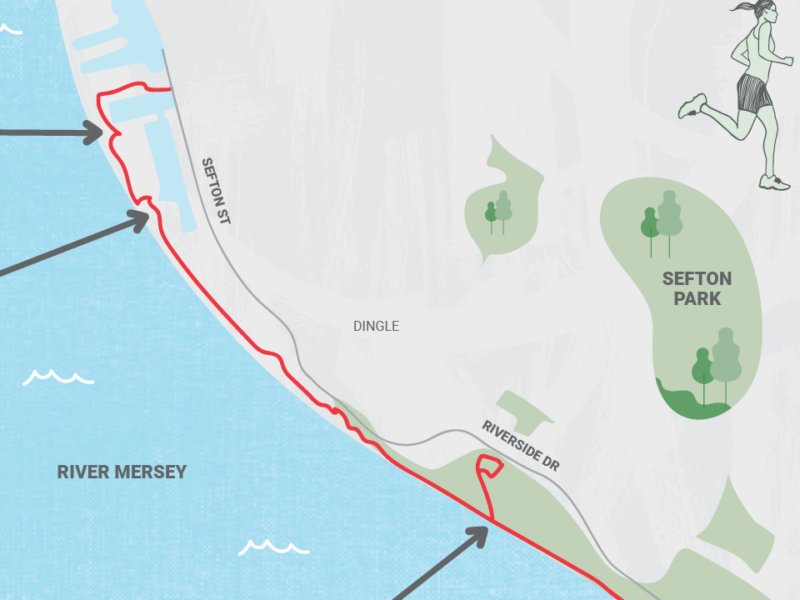Dock Route
Join us on a 5.2-kilometre flat bike ride around the Royal Albert Dock, where you’ll discover some of Liverpool’s most iconic landmarks.
Over the course of 45 minutes, we’ll visit the Liver Building, Britain’s first skyscraper, and the Cunard Building, once the headquarters of the Cunard Steamship Company. You’ll also stop at the Titanic Memorial, honouring Liverpool’s connection to the famous ship, and the Our Lady and St Nicholas Church, known as the sailor’s church, which dates back to the 13th century.
This leisurely ride also takes you through the historic Albert Dock, the world’s first enclosed dock warehouse system, and past the stunning Port of Liverpool Building, part of Liverpool’s renowned “Three Graces.” With beautiful waterfront views and rich historical context, this ride is the perfect way to enjoy the city while learning about its maritime heritage. Suitable for all levels of cyclists.
.
Distance: 5.2 km/ 3.2 miles
Time: estimated 30-35 mins
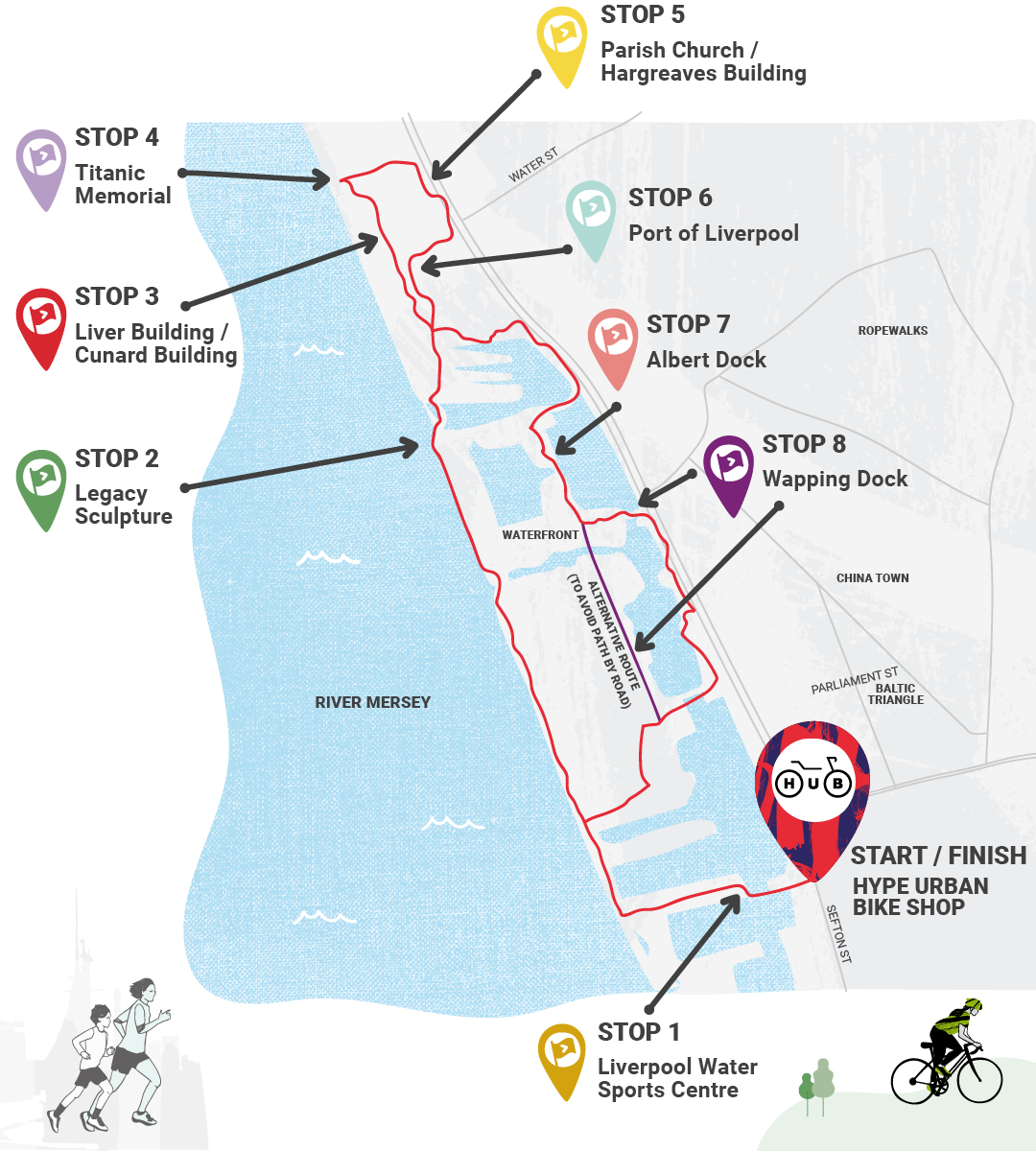
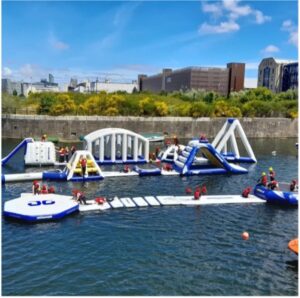
Liverpool Water Sports Centre is a part of the charitable organization called Local Solutions, which focuses on helping disadvantaged groups in Liverpool and North Wales. HYPE, our charity, collaborates closely with the Water Sports Centre to offer underprivileged young people the chance to participate in new activities and become part of a community. This project was initially established on the banks of the Leeds-Liverpool Canal in 1979 and was relocated here in 1994 to provide a wider range of activities to the entire community. The Centre offers a variety of activities, including sailing, kayaking, and inflatable obstacle courses.
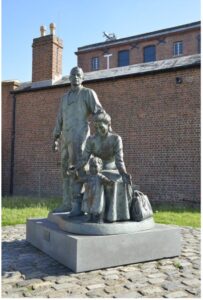
The old English name for Liverpool means ‘Muddy Pool’. King John founded the port of Liverpool in 1207. He saw Liverpool as an ideal place to form a base for his ships to invade Ireland and Wales. Liverpool’s docks and connection to the sea have been extremely important for Liverpool’s survival, especially concerning trade. In the 17th century, trade began to increase with Ireland and by 1666 Liverpool had entered the Oceanic trade with ships sailing to American colonies and returning with sugar, tobacco, and timber. Liverpool was the first UK city to import a banana! By the 19th century, Liverpool was receiving 9% of the entire world trade through its many docks. Cotton dominated this trade in which Liverpool achieved world domination and reigned supreme as ‘King Cotton’!
However, Liverpool did engage in other, more reprehensible types of trade. By the 18th Century Liverpool entered into the slave trade and came to hold world domination of this trade for more than a century. It is suggested that Liverpool’s ships carried half the world trade in slaves from Africa to America and the West Indies. The International Slavery Museum, located in Albert Docks, provides a thought-provoking, fascinating insight into historical and contemporary slavery, which I would recommend visiting.
Also, between 1830 and 1930, 9 million emigrants from Britain, Ireland and Europe set sail from Liverpool to begin a new life in America. This statue of a young family commemorates the migration from Liverpool to the New World. It captures the excitement and anticipation that millions of people felt when immigrating to America. The child stepping forward at the front symbolises migration to the unknown world whilst the child playing with a crab at the back indicates a deep association with the sea.
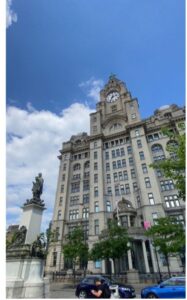
This building here is the Liver Building. It was completed in 1911, after 3-years of construction. The Liver Building is Britain’s first ‘skyscraper’ and is the second Grace of Liverpool. The clock face is the largest in the UK, bigger than Big Ben’s!
At the top of each tower, you can see two Liver Birds, the city’s emblem. One bird faces east while the other faces west. The tale of the two Liver Birds is linked to the city’s maritime heritage. The Liver Bird that looks over the Mersey River is said to represent the wives who stayed at home and looked out for their sailor husbands at sea. The Liver Bird that looks over the city is said to represent the sailors out at sea who are looking back over to their city and family. The Birds are allegedly called Bella and Bertie. According to local legend, if the two birds were to ever fly away, Liverpool would cease to exist.
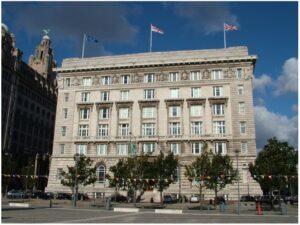
The Cunard Building, the Third Grace of Liverpool, is a historic building that was completed in 1916. It was built to serve as the headquarters and passenger terminal for The Cunard Steamship Company, which was one of the most renowned shipping lines of its time. The building’s architecture was influenced by both the Italian Renaissance and Greek Revival, resulting in a unique and stunning design that can still be admired today.
One of the features of the Cunard Building is the former passenger luggage room, which has been transformed into an exhibition space showcasing British popular music. Visitors can explore the rich history of the British music scene and learn about some of the most influential musicians and bands that have emerged from Liverpool.
Additionally, the statue of “Victory” outside the building is a reminder of the sacrifices made by Cunard employees during World War II. Erected in 1921, the statue serves as a memorial to those who lost their lives during the war.
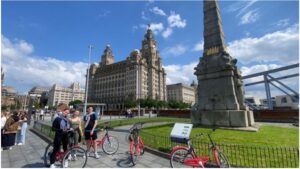
This is the Titanic memorial. Although the RMS Titanic never visited Liverpool, it was registered in Liverpool and carried the city’s name on its stern. The ship was built by the White Star Line during Liverpool’s prosperous era when the city was at the centre of global shipping. Many employees on the Titanic were from Liverpool or had a connection to the city. The ship’s captain, Edward John Smith, lived in Merseyside for 40 years and began his seafaring career in Liverpool at the age of 13. The bass violinist of the ship’s band, Fred Clarke, who famously continued playing while the Titanic sank, also lived in Liverpool.
Originally, it was intended to commemorate the 244 engine room staff who remained at their post after the ship hit the iceberg on April 15th, 1912, to keep the ship’s systems running as long as possible and help people escape as the ship sank. However, as more ships were lost or sank, particularly during the early years of the First World War, it was decided that the dedication of the memorial should be broadened to remember all the “heroes of the marine engine room.”
During the Second World War, the memorial was slightly damaged when an exploding bomb dropped on Liverpool hit it with shrapnel. Today, small chunks of the stonework are still missing in some places as a result of this damage.
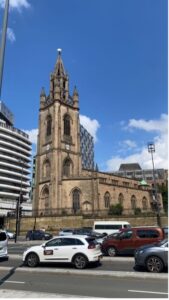
The Our Lady and St Nicholas Church, also known as the sailor’s church, has been here since the 13th century. The Spire acted as a navigation landmark for sailors to show they had reached home.
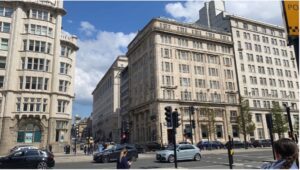
This building was built in 1859 for a Liverpool merchant, Sir William Brown. Huge volumes of British trade with North America and the Caribbean was carried by his Liverpool ships. The bar inside was nicknamed the ‘Dry Dock’ by building houses naval officers in WW2. During WW2 Liverpool became the most important port in the nation’s war effort.
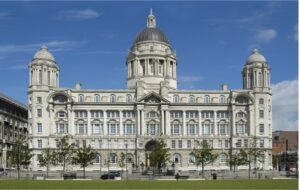
This building here is the Port of Liverpool, the first Grace and was built in 1907. It’s noted for its ornate architectural features and expensive decorative features that are reflective of Liverpool’s maritime links and importance in maintaining the British Empire. The buildings central dome wasn’t part of the original design, it was inspired by an unused design for Liverpool’s Anglican Cathedral.
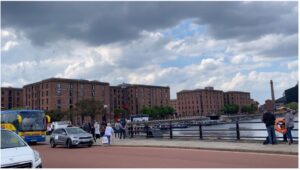
Albert Dock was the world’s first fully enclosed system of dock warehouses, known as a ‘port within a port’, built by Jesse Hartley. This dock dominated Liverpool’s East Indies trade for 30 years.
By 1920 Albert Dock was considered ‘dead in the water’ as new steamships could not pass through its narrow and shallow entrances. In 1972 the South Docks closed, and the entire dock system became unusable. This resulted in chemical mud filling the once vibrant docks, which were as deep as 2 double-decker buses! During renovation, this chemical mud had to be scooped out.
The west and north of Albert Docks are built on quicksand, so the dock rises and falls with each tide.
The Dock traffic office was built in the form of a classical Greek temple and was the main administration office for the Docks, controlling the storage and movement of goods.
The Salthouse Bridge and Dock, originally called the ‘Stand Bridge’ allowed empty ships to pass through. All these buildings surrounding here, used to be warehouses, for loading, unloading ships and storing goods. The Mersey Maritime Museum was originally a cold store in 1899. If you have time, the 4th-floor cafe has amazing views of the Albert Dock and the Pierhead and is the only place you can see the original stressed skin roof of the old warehouses, designed by Jesse Hartley.
The Dock traffic office was built in the form of a classical Greek temple and was the main administration office for the Docks, controlling the storage and movement of goods.
The Albert Docks stands today as the largest group of Grade 1 listed buildings in Britain: the grandest and most complete surviving example of the fully integrated Victorian warehouse dock. It now serves as one of the most popular tourist spots in England, welcoming 4 million visitors annually.
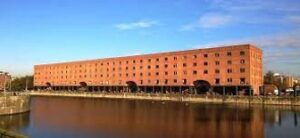
Wapping Dock was built in 1834 and is now part of Liverpool’s UNESCO World Heritage site. The dock was made to connect all the other docks, like Kings and Queens Docks, which we have just passed, to save ships from having to go into the river to get to access them. It was primarily used for warehousing rum and tobacco and was closed in 1982. The Wapping warehouses had major renovation in the 20th century after substantial bomb damage occurred during WW2.
Join a Ride
Signup form for bike rides

